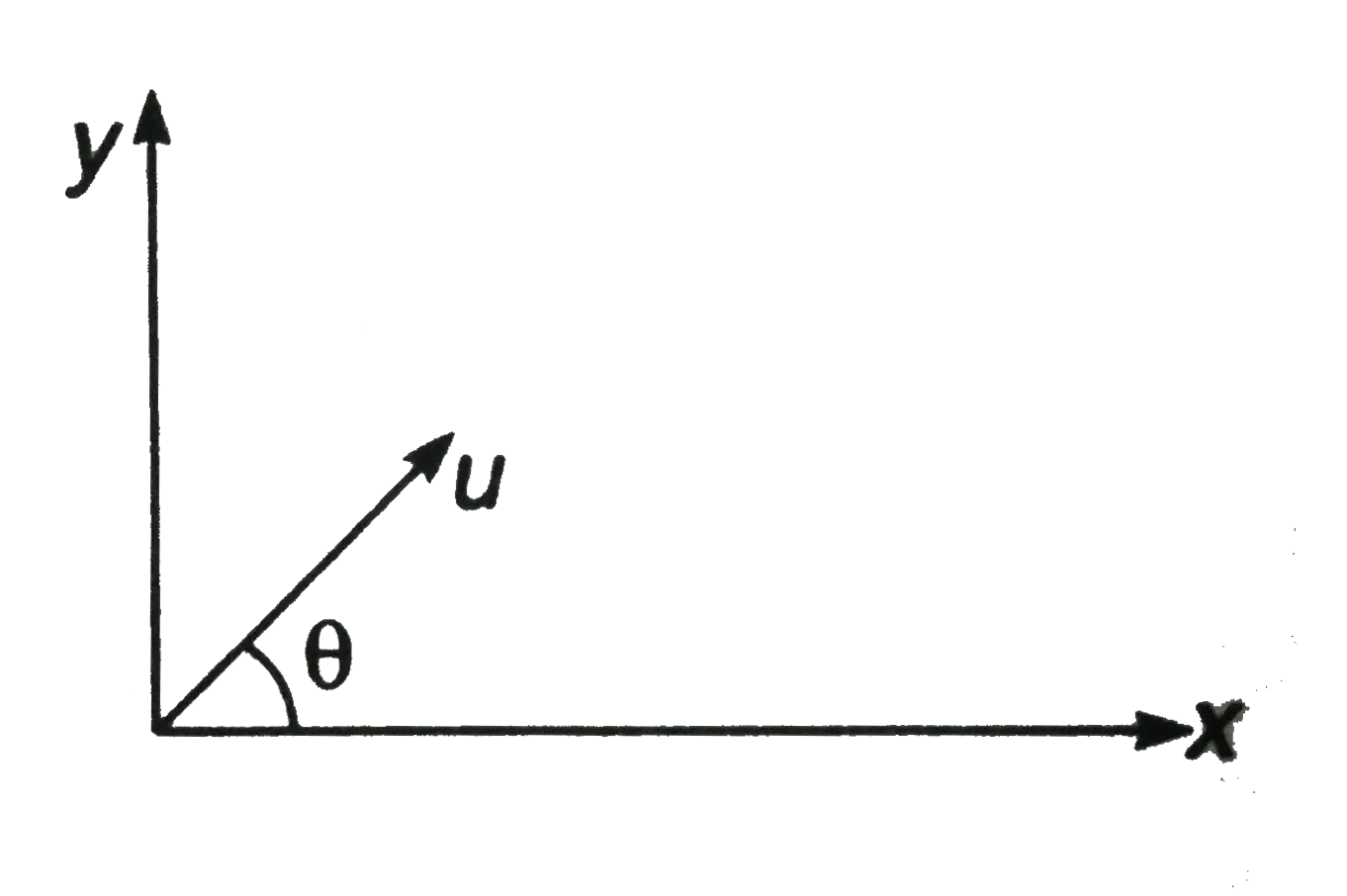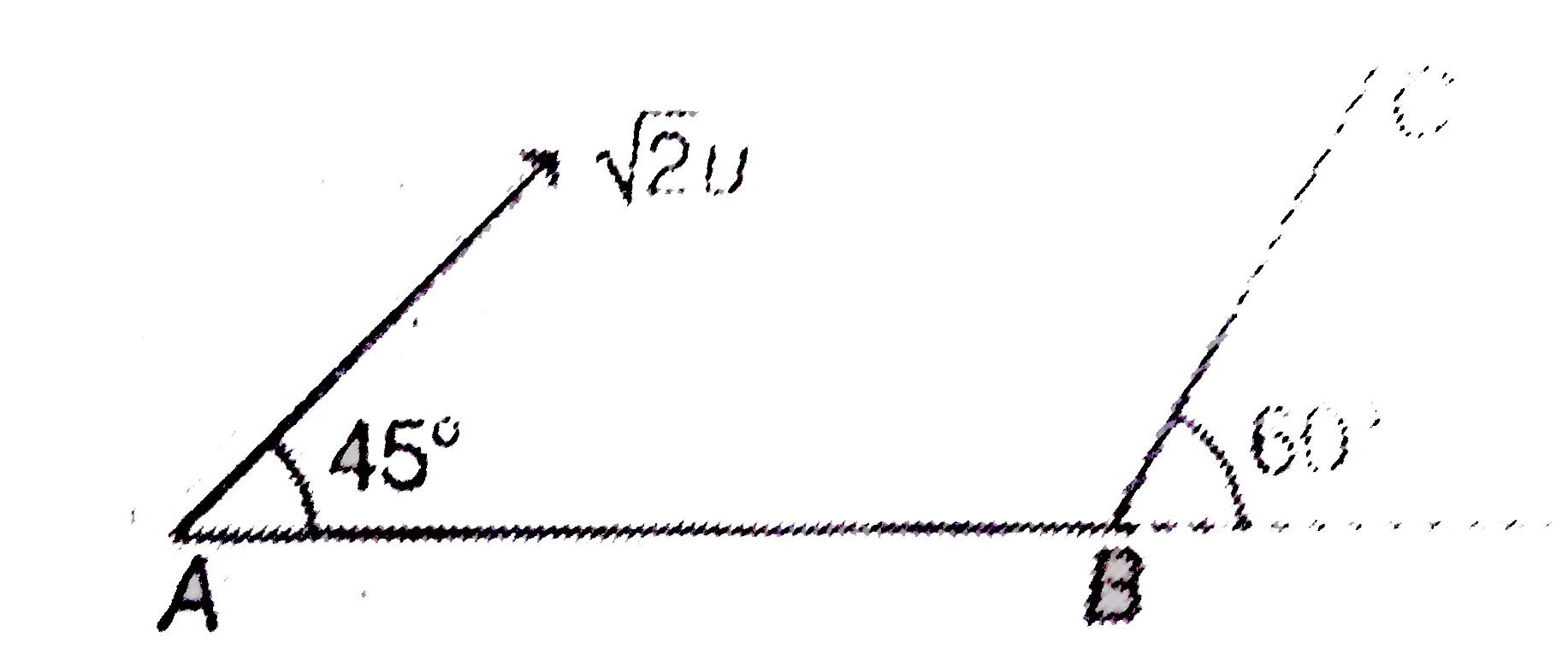A particle is projected from ground with velocity 40√2m/s at 45∘. At time t=2s
displacement of particle is 100m
vertical component of velocity is 20m/s
velocity makes an angle tan−1(2) with vertical
particle is at height of 60m from ground
The correct Answer is:A, B, C, D
To solve the problem, we need to analyze the motion of a particle projected from the ground with a given initial velocity and angle. Here are the steps to find the required quantities at time t=2 seconds.
Step 1: Identify the initial conditions
- Initial velocity u=40√2m/s
- Angle of projection θ=45∘
Step 2: Resolve the initial velocity into horizontal and vertical components
- The horizontal component of velocity Vx:
Vx=u⋅cos(θ)=40√2⋅cos(45∘)=40√2⋅1√2=40m/s
- The vertical component of velocity Vy:
Vy=u⋅sin(θ)=40√2⋅sin(45∘)=40√2⋅1√2=40m/s
Step 3: Calculate the displacements in the x and y directions
- The displacement in the x-direction Sx:
Sx=Vx⋅t=40⋅2=80m
- The displacement in the y-direction Sy:
Sy=Vy⋅t+12ayt2
where ay=−10m/s2 (acceleration due to gravity).
Sy=40⋅2+12(−10)⋅(22)=80−20=60m
Step 4: Calculate the resultant displacement
- The resultant displacement S can be calculated using Pythagoras' theorem:
S=√S2x+S2y=√802+602=√6400+3600=√10000=100m
Step 5: Calculate the vertical component of velocity at t=2s
- The vertical component of velocity Vy at time t:
Vy=Vy+ay⋅t=40−10⋅2=40−20=20m/s
Step 6: Calculate the angle of the resultant velocity with respect to the vertical
- The horizontal component remains Vx=40m/s and the vertical component is Vy=20m/s.
- The angle ϕ with respect to the vertical can be found using:
tan(ϕ)=VxVy=4020=2
Thus, ϕ=tan−1(2).
Step 7: Determine the height of the particle
- The height of the particle from the ground is Sy=60m.
Summary of Results
1. Displacement of the particle is 100m.
2. Vertical component of velocity is 20m/s.
3. Velocity makes an angle tan−1(2) with the vertical.
4. Particle is at a height of 60m from the ground.
- Initial velocity u=40√2m/s
- Angle of projection θ=45∘
- The horizontal component of velocity Vx:
Vx=u⋅cos(θ)=40√2⋅cos(45∘)=40√2⋅1√2=40m/s
Vy=u⋅sin(θ)=40√2⋅sin(45∘)=40√2⋅1√2=40m/s
- The displacement in the x-direction Sx:
Sx=Vx⋅t=40⋅2=80m
Sy=Vy⋅t+12ayt2
where ay=−10m/s2 (acceleration due to gravity).
Sy=40⋅2+12(−10)⋅(22)=80−20=60m
- The resultant displacement S can be calculated using Pythagoras' theorem:
S=√S2x+S2y=√802+602=√6400+3600=√10000=100m
- The vertical component of velocity Vy at time t:
Vy=Vy+ay⋅t=40−10⋅2=40−20=20m/s
- The horizontal component remains Vx=40m/s and the vertical component is Vy=20m/s.
- The angle ϕ with respect to the vertical can be found using:
tan(ϕ)=VxVy=4020=2
Thus, ϕ=tan−1(2).
- The height of the particle from the ground is Sy=60m.
1. Displacement of the particle is 100m.
2. Vertical component of velocity is 20m/s.
3. Velocity makes an angle tan−1(2) with the vertical.
4. Particle is at a height of 60m from the ground.
Topper's Solved these Questions
- KINEMATICSBOOK - DC PANDEY ENGLISHCHAPTER - KINEMATICSEXERCISE - COMPREHENSION_TYPE
13 Videos
- KINEMATICSBOOK - DC PANDEY ENGLISHCHAPTER - KINEMATICSEXERCISE - MATCH THE COLUMN
3 Videos
- KINEMATICSBOOK - DC PANDEY ENGLISHCHAPTER - KINEMATICSEXERCISE - SCQ_TYPE
39 Videos
- GRAVITATIONBOOK - DC PANDEY ENGLISHCHAPTER - GRAVITATIONEXERCISE - (C) Chapter Exercises
45 Videos
- KINEMATICS 1BOOK - DC PANDEY ENGLISHCHAPTER - KINEMATICS 1EXERCISE - INTEGER_TYPE
15 Videos
Similar Questions
A particle is projected from ground with velocity 20(√2)m/s at 45∘. At what time particle is at height 15 m from ground? (g=10m/s2)
View SolutionA particle is projected from ground with velocity 40(√2)m/s at 45∘. Find
(a) velocity and
(b) displacement of the particle after 2 s. (g=10m/s2)
View SolutionA projectile of mass 3m is projected from ground with velocity 20√2m/s at 45∘. At highest point it explodes into two pieces. One of mass 2m and the other of mass m. Both the pieces fly off horizontally in opposite directions. Mass 2m falls at a distance of 100m from point of projection. Find the distance of second mass from point of projection where it strikes the ground.
(g=10m/s2)
View SolutionA particle is projected from ground with initial velocity u=20(√2)m/s at θ=45∘. Find
(a) R,H and T,
(b) velocity of particle after 1 s
(c) velocity of particle at the time of collision with the ground (x-axis).

View SolutionA particle is projected from a tower of height 25 m with velocity 20√2m/s at 45∘. (a) Find the time when particle strikes with ground. (b) The horizontal distance from the foot of tower where it strikes. (c) Also find the velocity at the time of collision.
View SolutionA particle is projected from ground with velocity 50m/s at 37∘ from horizontal. Find velocity and displacement after 2 s. sin37∘=35.
View SolutionA particle is projected with velocity 20√2m/s at 45∘ with horizontal. After 1s , find tangential and normal acceleration of the particle. Also, find radius of curvature of the trajectory at that point. (Take g=10m/s2)
View SolutionA particle is projected from a point A with velocity √2u an angle of 45∘ with horizontal as shown in figure. It strikes the plane BC at right angles. The velocity of the particle at the time of collision is

View SolutionA particle is projected from ground at angle 45∘ with initial velocity 20(√2)m/s. Find
(a) change in velocity,
(b) magnitude of average velocity in a time interval from t=0 to t=3s.
View SolutionA particle is projected vertically upwards from ground with velocity 10 m/s. Find the time taken by it to reach at the highest point ?
View Solution
